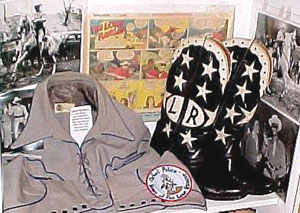
This story is posted on the Fawcett Toy & Art Museum web site as a tribute to my friend and fellow collector, Karl Rommel. Karl and I spoke every week or two for many years. He was a great guy, an old time radio fan and a long time collector of Lone Ranger memorabilia. Karl is pictured on the right.

Copyright 2002 by John S. Fawcett
As collectors, we all obsess on finding those rare and unique items that would be the ultimate collectible in our specialized area of interest. For a Wizard of Oz collector, it might be one of the pairs of Judy Garland's ruby slippers. For a puppet collector, it might be the original Howdy Doody marionette or the original Charlie McCarthy dummy. I'm sure all collectors dream of those magical unique items that they can only hope to own someday.
I am a Lone Ranger collector. Growing up in the 1940s,
the Lone Ranger myth was broadcast into my home from the studios of WXYZ
radio in Detroit. Every Monday, Wednesday, and Friday night at 7:30, wonderful
stories of "the masked rider of the plains" and his exciting
premium offers became a major part of my young life. 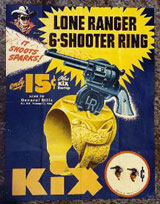
Over the airways during the cold January nights of 1948, a series of four programs were broadcast that were to produce a collector's dream that was to finally come true 44 years later. Those four programs were based around the unique qualities of the Lone Ranger's Colt pistols and special pistol rings sent by Sam Colt to the Lone Ranger and his nephew, Dan Reid. Spies were after the Lone Ranger's guns. These were very special guns with newer, quicker firing mechanisms made especially for the Ranger by Sam Colt.
I sent my cereal boxtop and cash for the Lone Ranger's
pistol ring premium. It sounded terrific and that ring remains a favorite
of mine to this day. But I also dreamed how special it would be to actually
own and hold the Lone Ranger's gun. The mythical guns that sent silver
bullets flying through the air in the name of justice. Guns that never
shot to kill but only to disarm the outlaws. Sure, I had Lone Ranger cap
pistols with which I could pretend, but they were only children's fantasy
toys. I knew the difference between reality and fantasy. I wanted to have
and own the real Lone Ranger Colt .45 peacemaker pistol. 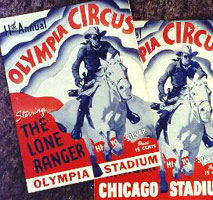
Brace Beemer was the personification of "my"
Lone Ranger. He was the deep booming voice that portrayed the masked man
on radio from 1941 to the mid 1950s. Beemer made many personal appearances
in full
costume as the Lone Ranger. He visited children's hospitals, appeared
at rodeos, and even took his guns to Washington D.C. The Lone Ranger and
his pistols have been to the FBI, the halls of congress, and to the White
House. Brace Beemer, the mythic Lone Ranger, was a true American hero.
Karl Rommel, a Lone Ranger collector from Michigan,
called me one evening. Karl was a friend of the Beemer family. Through
them he had been able to obtain a few cherished pieces of the Lone Ranger
costume. He told me that he was saving his money. Brace Beemer's son was
about to sell him the Lone Ranger's pistols. He would meet with Mr. Beemer
later in the week to try and work out a deal. I wished him good luck and
was very happy and excited for him.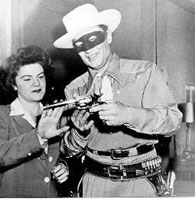
A few weeks later, I received another call. Karl was very despondent. He had met with Richard Beemer. He had seen and actually held the Lone Ranger's guns. However, there was a very big fly in the ointment, a gun dealer had become involved and had offered a large amount of money for the pistols. Five times the amount of money that my friend hoped he would have to spend to buy the guns.
Richard Beemer said he wanted his dad's guns to go to a place where they would be appreciated and not to a dealer who would put them up for resale. He told Karl that he would sell him the Lone Ranger's pistols for $10,000 less than he had been offered by the gun dealer. However, this price was still more money than my friend could raise. The money was a sum far beyond his means. There was no way he could quickly come up with that large amount of cash. So, it appeared that the guns were going to be sold to the gun dealer. Once in the dealer’s possession, who knew what they would cost or where the pistols would wind up? Karl was sad and I commiserated with him. I knew how unhappy I would feel if I had just lost my opportunity to own the Lone Ranger's guns. Our conversation ended a few minutes later and we hung up the phones.
Ten minutes passed, then my own collector's mind went into overdrive. I called Karl back with an idea that could make the dream a reality for the both of us.
"Lets split the cost! There are two guns; I get
one, and you get one. If we divide the money Beemer wants in half, the
price is much more within reach. While we stretch our limited funds in
order to be able to purchase them, the guns go to a "good home"
and not to the gun dealer. The old saying "half a loaf is better
than none" applies here. This is the only opportunity we'll have.
Approach Mr. Beemer and see if he will go for it. If he does, I'll have
a bank check in the mail right away." Karl said he'd give my proposition
a try. I was excited. The possibility of actually owning one of the Lone
Ranger's guns was racing through my mind. I didn't sleep too well that
evening as I obsessed on my childhood dream of actually holding the Lone
Ranger's pistol.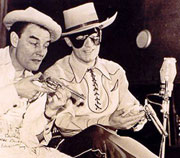
A few days later I heard from my friend. Beemer would accept our offer. We could purchase the Lone Ranger's Colt .45 pistols. I put my money in the mail.
In order to purchase a handgun in one state and mail it to another requires that collectors obtain permits and use federally licensed gun dealers. The red tape and laws involved seem to me to be excessive and complex for what would ordinarily be a simple collector's transaction. America has teenagers acquiring illegal machine guns and pistols every day. Weapons that are easily obtainable on the streets of our cities. Here I was, an honest citizen, about to purchase his first "real" gun and the red tape seemed endless. There were lots of hoops to jump through in order to legally ship the Lone Ranger's pistol from Michigan to Connecticut.
Two weeks after mailing my check, the gun finally
had arrived at my local gun dealer. I went right over to the shop and
waited as the package was opened in my presence. From the box came a silver
Colt .45 peacemaker pistol with ivory handles. He checked the serial numbers...
"91973" He looked it up. "Boy, that's old! 1880s."
He checked the papers that came with the pistol. "Brace Beemer, profession-radio
broadcasting." Here it was, I was actually holding it in my hands.
This gleaming beauty really was the Lone Ranger's pistol. It was exciting
and thrilling for the both the dealer and myself. Needless to say, I was
having a major adrenaline rush. 
An eight-year-old boy's fantasy to own and hold the
Lone Ranger's gun had finally come true. The fantasy that began with the
pistol ring stories broadcast over the radio during the cold winter nights
of January 1948 had finally ended 44 years later in the hands of a 52-year-old
man. Even if they must take a very long time, some collector's dreams
can still come true. I was now the owner of one of the ultimate Lone Ranger
items. I was now the  owner
of the Lone Ranger's gun.
owner
of the Lone Ranger's gun.
Karl Rommel and I formed an agreement. Both of us
knew we would never sell our Lone Ranger pistol during our lifetime. However
if for some reason the gun must be sold, it would be offered to the
other person at the original cost. If one of us died, the survivor would
be able to purchase the 2nd pistol to reunite the pair. Karl has since
passed on. Cancer claimed him far too early and I miss him a lot. I wish
I could still talk to him every couple of weeks. I wish he were still
here to share our joint ownership of the Beemer pistols. I would much
rather have Karl around than to own the second Beemer pistol. Our
agreement was honored by his son, Kurt Rommel. The second Lone Ranger
pistol was acquired in the spring of 2002. Both pistols and other original
Brace Beemer Lone Ranger items from the Rommel collection are
now on display in Fawcett’s Antique Toy & Art Museum in
Waldoboro Maine.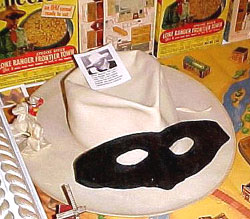

The collection includes of some of the original
WXYZ radio and Dell comic book cover paintings.
Below Lone Ranger #92, 1956 Dell Comic art
by Hank Hartman.
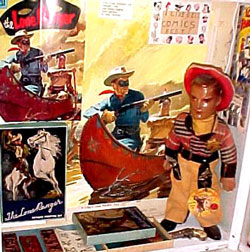
Brace
Breemer's original Lone Ranger hat
and mask above and shirt and boots below.
